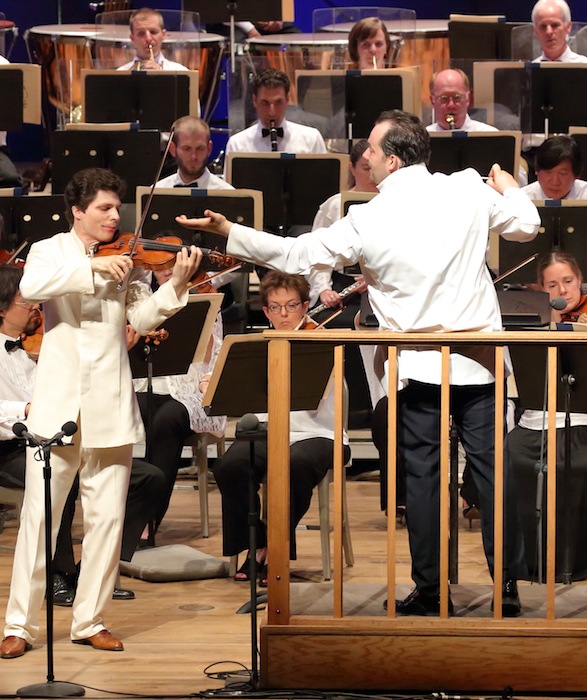Nelsons, BSO invigorate Beethoven and Sibelius at Tanglewood

Augustin Hadelich performed Sibelius’s Violin Concerto with Andris Nelsons and the Boston Symphony Orchestra Saturday night at Tanglewood. Photo: Hilary Scott
The Andris Nelsons era with the Boston Symphony Orchestra has been one largely reliant on standard repertory with occasional new and recent works thrown into the mix.
Saturday night at Tanglewood’s Koussevitzky Shed, Nelsons led John Corigliano’s Fantasia on an Ostinato, marking only the second time that the orchestra has performed the work. (The first was at Tanglewood in 1992.)
In this case, the word “recent” should be taken with a grain of salt as Corigliano’s work, originally for piano, dates from 1986. In its orchestral form, the piece retains a freshness that is still riveting thirty years later.
Clocking in at less than fifteen minutes, Fantasia on an Ostinato is based on the repetitive pattern that serves as the basis for the second movement of Beethoven’s Seventh Symphony. The composer makes economical use of the source material, abstracting it at times to little more than a pulse. At others, the original theme forms from the musical ether, like a ghost, before evaporating into clouds of harmonies.
Above all, Fantasia on an Ostinato is a colorful work to listen to. The orchestration runs the gamut from low groans to shimmering timbres, supplied expertly by the BSO winds and percussion.
Nelsons led a committed reading that built the music into impressive structures of sound, and the orchestra responded with playing of sparkling intensity. Corigliano joined Nelsons onstage for bows, and the audience rewarded them with a standing ovation.
The listeners had the chance to compare Corigliano’s work with its inspiration, Beethoven’s Seventh Symphony, which made up the second half of the concert.
Nelsons’ Beethoven is rife with dramatic flair and full of surging vitality that added an extra energy to a piece that already pulses with rhythm.
In the first movement, Nelsons opted for taut control of the finer details of the score, coaxing an accent here and shaping a decrescendo there. The famous theme of the second movement unfolded in vocal arcs as each phrase and variation stacked upon the other for a soft blanket of sound. The third and fourth movements had buoyant energy, with the BSO bringing the music to vivid life.
Rounding out the concert was Sibelius’s Violin Concerto, which spotlighted Augustin Hadelich as soloist.
At 32 years old, the German violinist commands a full, singing tone and spectacular technique, though he doesn’t flaunt either. He kept the piece’s virtuosic flair under tight control, and he played with a smoothness of tone that brought a supple and understated quality to this barnstorming concerto. That may, in part, be due to Hadelich’s instrument, a 1723 “Ex-Kiesewetter,” which sounded with a silvery glow.
The opening melody of the first movement seemed to evolve out of the mist, with Hadelich’s tone taking on an icy exterior. Even the darting lines of the finale had a smooth polish to the sound. In the second movement, Hadelich’s instrument displayed a warmer, amber-laced tone, and the movement’s hymn-like lines wove together in a supple tapestry.
Nelsons led an accompaniment that was finely tuned to the dialogue between soloist and orchestra, walking the line in the finale between rustic energy and primordial pulses.
The lightening passages that conclude the concerto brought the audience to its feet. After several curtain calls, Hadelich offered an encore, a silky rendition of the Andante from Bach’s Second Sonata for Violin.
_____________
Saturday afternoon at Ozawa Hall, the Boston University Tanglewood Institute offered Mahler’s Sixth Symphony. Once known as the “Tragic,” the eighty-five minute work is filled with stirring power and emotional intensity.
That was certainly the impression given at Saturday’s bracing performance. The orchestra, comprising young musicians from around the country, plays with a cohesiveness that could rival most mid-level professional ensembles. Strong in all sections, the orchestra beamed with bright string sound, soft, caressing woodwind sonorities, and brass and percussion sections capable of supplying Mahler’s work with the requisite weight.
The conductor, Paul Haas, is an energetic presence on the podium, guiding with a mix of scooping and criss-crossing gestures. He coaxed playing of powerful energy as he led the first movement with furious drive.
The Scherzo had equal parts pomp and rustic simplicity, offset by cellos, basses, and tuba in a low, earthy growl. The third movement, which unfolded in statements of soft elegance, spotlighted glowing solos from principal oboe, French horn, and clarinet.
The finale moves from tragedy to triumph and back again. Haas built the music to a sturdy climax. The hammer blows heralded passages of bristling intensity to bring the symphony to a rousing conclusion.